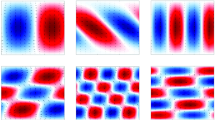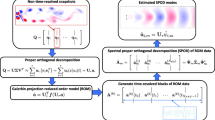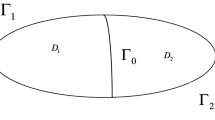Abstract
The use of spectral proper orthogonal decomposition (SPOD) to construct low-order models for broadband turbulent flows is explored. The choice of SPOD modes as basis vectors is motivated by their optimality and space-time coherence properties for statistically stationary flows. This work follows the modeling paradigm that complex nonlinear fluid dynamics can be approximated as stochastically forced linear systems. The proposed stochastic two-level SPOD-Galerkin model governs a compound state consisting of the modal expansion coefficients and forcing coefficients. In the first level, the modal expansion coefficients are advanced by the forced linearized Navier-Stokes operator under the linear time-invariant assumption. The second level governs the forcing coefficients, which compensate for the offset between the linear approximation and the true state. At this level, least squares regression is used to achieve closure by modeling nonlinear interactions between modes. The statistics of the remaining residue are used to construct a dewhitening filter that facilitates the use of white noise to drive the model. If the data residue is used as the sole input, the model accurately recovers the original flow trajectory for all times. If the residue is modeled as stochastic input, then the model generates surrogate data that accurately reproduces the second-order statistics and dynamics of the original data. The stochastic model uncertainty, predictability, and stability are quantified analytically and through Monte Carlo simulations. The model is demonstrated on large eddy simulation data of a turbulent jet at Mach number \(M=0.9\) and Reynolds number \(\mathrm {Re}_D\approx 10^6\).















Similar content being viewed by others
References
Aubry, N., Holmes, P., Lumley, J.L., Stone, E.: The dynamics of coherent structures in the wall region of a turbulent boundary layer. J. Fluid Mech. 192, 115–173 (1988)
Barone, M.F., Kalashnikova, I., Segalman, D.J., Thornquist, H.K.: Stable galerkin reduced order models for linearized compressible flow. J. Compt. Phys. 228(6), 1932–1946 (2009)
Brès, G.A., Jordan, P., Jaunet, V., Le Rallic, M., Cavalieri, A.V.G., Towne, A., Lele, S.K., Colonius, T., Schmidt, O.T.: Importance of the nozzle-exit boundary-layer state in subsonic turbulent jets. J. Fluid Mech. 851, 83–124 (2018)
Cavalieri, André VG., Rodríguez, Daniel, Jordan, Peter, Colonius, Tim, Gervais, Yves: Wavepackets in the velocity field of turbulent jets. J. Fluid Mech. 730, 559–592 (2013)
Chekroun, M.D., Kondrashov, D.: Data-adaptive harmonic spectra and multilayer stuart-landau models. Chaos: Interdiscip. J. Nonlinear Sci. 27(9), 093110 (2017)
Chu, B.-T.: On the energy transfer to small disturbances in fluid flow (part 1). Acta Mech. 1(3), 215–234 (1965)
Drohmann, M., Carlberg, K.: The romes method for statistical modeling of reduced-order-model error. SIAM/ASA J. Uncertain. Quantif. 3(1), 116–145 (2015)
Glauser, M, N., Leib, S. J., Geroge, W. K.: Coherent structures in the axisymmetric turbulent jet mixing layer. In: Turbulent Shear Flows 5, (ed. F. Durst et al.), pp. 134–145. Springer. (1987)
Gordeyev, S.V., Thomas, F.O.: Coherent structure in the turbulent planar jet. Part 1. Extraction of proper orthogonal decomposition eigenmodes and their self-similarity. J. Fluid Mech. 414, 145–194 (2000)
Gudmundsson, K., Colonius, T.: Instability wave models for the near-field fluctuations of turbulent jets. J. Fluid Mech. 689, 97–128 (2011)
Holmes, P., Lumley, J.L., Berkooz, G.: Turbulence, Coherent Structures, Dynamical Systems and Symmetry. Cambridge University Press, Cambridge (1996)
Holmes, P., Lumley, J.L., Berkooz, G., Mattingly, J.C., Wittenberg, R.W.: Low-dimensional models of coherent structures in turbulence. Phys. Rep. 287(4), 337–384 (1997)
Hussain, A.K.M.F., Reynolds, W.C.: The mechanics of an organized wave in turbulent shear flow. J. Fluid Mech. 41(2), 241–258 (1970)
Johnson, S.D., Battisti, D.S., Sarachik, E.S.: Empirically derived markov models and prediction of tropical pacific sea surface temperature anomalies. J. Clim. 13(1), 3–17 (2000)
Kalashnikova, I., Barone, M.F.: Stable and efficient galerkin reduced order models for non-linear fluid flow. In: 6th AIAA Theoretical Fluid Mechanics Conference, p. 3110 (2011)
Kalashnikova, I., Barone, M.F.: Efficient non-linear proper orthogonal decomposition/galerkin reduced order models with stable penalty enforcement of boundary conditions. Int. J. Numer. Meth. Eng. 90(11), 1337–1362 (2012)
Kondrashov, D., Chekroun, M.D., Ghil, M.: Data-driven non-markovian closure models. Phys. D 297, 33–55 (2015)
Kondrashov, D., Kravtsov, S., Robertson, A.W., Ghil, M.: A hierarchy of data-based enso models. J. Clim. 18(21), 4425–4444 (2005)
Kravtsov, S., Kondrashov, D., Ghil, M.: Multilevel regression modeling of nonlinear processes: derivation and applications to climatic variability. J. Clim. 18(21), 4404–4424 (2005)
Lumley, J. L. (1967) The structure of inhomogeneous turbulent flows. In Atmospheric turbulence and radio wave propagation (ed. A. M. Yaglom& V. I. Tatarski), pp. 166–178. Nauka
Lumley, J.L.: Stochastic Tools in Turbulence. Academic Press, Cambridge (1970)
Nekkanti, A., Schmidt, O. T.: Frequency-time analysis, low-rank reconstruction and denoising of turbulent flows using spod. arXiv preprint arXiv:2011.03644 (2020)
Noack, B.R., Afanasiev, K., Morzyński, M., Tadmor, G., Thiele, F.: A hierarchy of low-dimensional models for the transient and post-transient cylinder wake. J. Fluid Mech. 497, 335–363 (2003)
Penland, C.: Random forcing and forecasting using principal oscillation pattern analysis. Mon. Weather Rev. 117(10), 2165–2185 (1989)
Penland, C.: A stochastic model of indopacific sea surface temperature anomalies. Phys. D 98(2–4), 534–558 (1996)
Penland, C., Matrosova, L.: Prediction of tropical atlantic sea surface temperatures using linear inverse modeling. J. Clim. 11(3), 483–496 (1998)
Penland, C., Sardeshmukh, P.D.: The optimal growth of tropical sea surface temperature anomalies. J. Clim. 8(8), 1999–2024 (1995)
Rempfer, D.: On low-dimensional galerkin models for fluid flow. Theor. Comput. Fluid Dyn. 14(2), 75–88 (2000)
Rowley, C. W.: Modeling, simulation, and control of cavity flow oscillations. PhD thesis, California Institute of Technology (2002)
Rowley, C. W., Colonius, T., Murray, R.: Dynamical models for control of cavity oscillations. In: AIAA Pap., p. 2126 (2001)
Rowley, C.W., Colonius, T., Murray, R.M.: Model reduction for compressible flows using pod and galerkin projection. Phys. D 189(1–2), 115–129 (2004)
Rowley, C.W., Dawson, S.T.: Model reduction for flow analysis and control. Annu. Rev. Fluid Mech. 49, 387–417 (2017)
Schmidt, O.T., Colonius, T.: Guide to spectral proper orthogonal decomposition. AIAA J. 58(3), 1023–1033 (2020)
Schmidt, O. T., Colonius, T., Bres, G. A.: Wavepacket intermittency and its role in turbulent jet noise. In: 55th AIAA Aerospace Sciences Meeting, p. 0686 (2017a)
Schmidt, O.T., Towne, A., Colonius, T., Cavalieri, A.V., Jordan, P., Brès, G.A.: Wavepackets and trapped acoustic modes in a turbulent jet: coherent structure eduction and global stability. J. Fluid Mech. 825, 1153–1181 (2017)
Schmidt, O.T., Towne, A., Rigas, G., Colonius, T., Brès, G.A.: Spectral analysis of jet turbulence. J. Fluid Mech. 855, 953–982 (2018)
Sirovich, L.: Turbulence and the dynamics of coherent structures. I. Coherent structures. Quart. Appl. Math. 45(3), 561–571 (1987)
Stengel, R.F.: Stochastic Optimal Control: Theory and Application. Wiley, New York (1986)
Towne, A., Cavalieri, A.V., Jordan, P., Colonius, T., Schmidt, O., Jaunet, V., Brès, G.A.: Acoustic resonance in the potential core of subsonic jets. J. Fluid Mech. 825, 1113–1152 (2017)
Towne, A., Schmidt, O.T., Colonius, T.: Spectral proper orthogonal decomposition and its relationship to dynamic mode decomposition and resolvent analysis. J. Fluid Mech. 847, 821–867 (2018)
Tutkun, M., George, W.K.: Lumley decomposition of turbulent boundary layer at high reynolds numbers. Phys. Fluids 29(2), 020707 (2017)
Tutkun, M., Johansson, P.B.V., George, W.K.: Three-component vectorial proper orthogonal decomposition of axisymmetric wake behind a disk. AIAA J. 46(5), 1118–1134 (2008)
Van Trees, H.L.: Detection, Estimation, and Modulation Theory, Part I. Wiley, New York (1968)
Zare, A., Jovanović, M.R., Georgiou, T.G.: Colour of turbulence. J. Fluid Mech. 812, 636–680 (2017)
Author information
Authors and Affiliations
Corresponding author
Ethics declarations
Conflict of interests
The authors report no conflict of interest.
Additional information
Communicated by Luca Magri.
Publisher's Note
Springer Nature remains neutral with regard to jurisdictional claims in published maps and institutional affiliations.
Stochastic SPOD-Galerkin two-level model for rank 2\(\times \)129 and rank 3\(\times \)129 cases
Stochastic SPOD-Galerkin two-level model for rank 2\(\times \)129 and rank 3\(\times \)129 cases
This appendix reports the additional results for the rank \(2\times 129\) and rank \(3\times 129\) cases, which were omitted in Sect. 4.3 for brevity. Figure 16a–d show the comparison between the power spectra of the state coefficients \(\varvec{a}_i\) and the rank \(2\times 129\) expansion coefficients at different frequencies. Figure 16e–h report the corresponding results for the rank 3\(\times \)129 case. Good agreements between the approximations and models are observed in both cases. The corresponding SPOD eigenvalue spectra shown in Fig. 16i,j show that both models accurately reproduce the eigenvalue spectra of the LES data for a wide range of frequencies. From these observations and the favorable results obtained for the \(1\times 129\) baseline model, as previously reported in Figs. 10 and 15, it concluded that subdominant SPOD modes are not required in the modal expansion.
Power spectra of the state coefficients \(\varvec{a}_i\) of low-rank approximations (red) and 2–level models (black) of rank 2\(\times \)129 (first row) and rank 3\(\times \)129 (second row) at four representative frequencies: a,e \(St=0.2\); b,f \(St=0.41\); c,g \(St=0.63\); d,h \(St=0.85\). Comparison of SPOD eigenvalue spectra of the LES data (black), low-rank approximations (blue) and 2–level models (red): i rank \(2\times 129\); j rank \(3\times 129\). Compare Figs. 10, 12 and 15
Rights and permissions
About this article
Cite this article
Chu, T., Schmidt, O.T. A stochastic SPOD-Galerkin model for broadband turbulent flows. Theor. Comput. Fluid Dyn. 35, 759–782 (2021). https://doi.org/10.1007/s00162-021-00588-6
Received:
Accepted:
Published:
Issue Date:
DOI: https://doi.org/10.1007/s00162-021-00588-6





